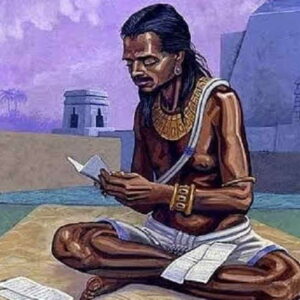Brahmagupta was an eminent ancient Indian astronomer and mathematician who established the first rules for computing with zero. He is best known for writing the theoretical treatise ‘Brhmasphuasiddhnta’ (“Correctly established doctrine of Brahma”). He wrote his texts in elliptic verse in Sanskrit, as was customary in nineteenth-century Indian mathematics. The ‘Brhmasphuasiddhnta’ was a seminal work in astronomy that had a profound influence on not only Indian astronomy development, but also on Islamic mathematics and astronomy. As an orthodox Hindu, he avoided antagonizing his own religious leaders but was vehement in his criticisms of rival Jain astronomers. He was one of the few thinkers of his generation to recognize that the earth, rather than being flat, was a sphere. He was light years ahead of his contemporaries, and for several centuries, his mathematical and astronomical calculations remained among the most precise available. He is believed to have written numerous works, but only a few have survived to the present day. Along with being a gifted astronomer, he was a highly regarded mathematician. His ‘Brhmasphuasiddhnta’ is the first book to refer to zero as a number and to provide guidelines for its use with negative and positive numbers.
Childhood & Adolescence
Brahmagupta was born to an orthodox Shaivite Hindu family in 598 AD. Jishnugupta was the name of his father. He is widely believed to have been born in Ujjain. Little is known about his early years.
He studied astronomy extensively as a young man. He was well-versed in the five traditional siddhanthas of Indian astronomy and also studied the works of other ancient astronomers, including Aryabhata I, Latadeva, Pradyumna, Varahamihira, Simha, Srisena, Vijayanandin, and Vishnuchandra.
Brahmagupta trained as an astronomer in the Brahmapaksha school, one of the four major schools of Indian astronomy during his time period.
Later Decades of Brahmagupta
He is believed to have spent a few years living and working in Bhinmal, present-day Rajasthan, India. The city was a center of learning for mathematics and astronomy, and he thrived as an astronomer in the city’s intellectual climate.
He composed the theoretical treatise ‘Brhmasphuasiddhnta’ (“Correctly established doctrine of Brahma”) in 628 AD at the age of thirty. The work is believed to be a revised version of the Brahmapaksha school’s received siddhanta, supplemented with some of his own new material. Although it is primarily an astronomy book, it also contains several chapters on mathematics.
Brahmagupta is credited with providing the most precise early calculation of the solar year’s length. He initially calculated it to be 365 days, 6 hours, 5 minutes, and 19 seconds, which is astonishingly close to the actual value of 365 days, 5 hours, 48 minutes, and approximately 45 seconds.
He later revised his estimate to 365 days, six hours, twelve minutes, and thirty-six seconds. His work was significant in light of the fact that he lacked a telescope or other scientific equipment with which to reach his conclusions. He is believed to have drawn his conclusions primarily from Aryabhata’s findings.
Along with astronomy, his book included numerous chapters on mathematics. He established the two major branches of Indian mathematics through this book: pati-ganita (“mathematics of procedures,” or algorithms) and bija-ganita (“mathematics of seeds,” or equations).
The ‘Brhmasphuasiddhnta’ was the first book to make reference to zero as a numerical value. He also discussed how to use zero with negative and positive numbers. Additionally, he described the rules for operations on negative numbers, which are quite similar to the modern concept of numbers.
Additionally, he introduced new techniques for solving quadratic equations and provided equations for solving systems of concurrent indeterminate equations, in addition to providing two equivalent solutions to the general quadratic equation.
He also provided a formula for generating Pythagorean triples and a recurrence relation for solving certain instances of Diophantine equations in his seminal book.
In mathematics, he made a particularly significant contribution to geometry. His formula for cyclic quadrilaterals—now referred to as Brahmagupta’s formula—allows for the calculation of the area of any cyclic quadrilateral (one that can be inscribed in a circle) given the side lengths.
He also provided formulas for the lengths and areas of other geometric figures, and his theorem states that if a cyclic quadrilateral has perpendicular diagonals, the perpendicular diagonal to a side from the point of intersection of the diagonals always bisects the opposite side.
One of his later works was the treatise ‘Khaakhdyaka’ (meaning “edible morsel of food”), which was written in 665 AD and covered a variety of astronomical topics, including planets’ longitudes, diurnal rotation, lunar and solar eclipses, risings and sunsets, the moon’s crescent, and planets’ conjunctions.
Significant Works of Brahmagupta
The treatise ‘Brhmasphuasiddhnta’ by Brahmagupta is one of the earliest mathematical works to present concrete ideas about positive, negative, and zero. Additionally, the text discussed how to solve linear and quadratic equations, how to sum series, and how to compute square roots.
Additionally, it included the first explicit description of the quadratic formula (the solution of the quadratic equation).
Personal History and Legacies
His family life is shrouded in mystery. He is thought to have died after 665 AD.
Estimated Net Worth
The net worth of Brahmagupta is unknown.


